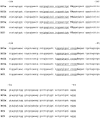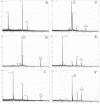Matrix-assisted laser desorption ionization-time of flight (mass spectrometry) for hepatitis C virus genotyping
- PMID: 15956402
- PMCID: PMC1151883
- DOI: 10.1128/JCM.43.6.2810-2815.2005
Matrix-assisted laser desorption ionization-time of flight (mass spectrometry) for hepatitis C virus genotyping
Abstract
Determination of the hepatitis C virus (HCV) genotype has become accepted as the standard procedure in laboratory practice. Genotype assignment helps in disease prognosis and assists in establishing the appropriate duration of treatment. More than 10 types and 70 subtypes of HCV have been described. In Russia the most common subtypes are 1a, 1b, 2a, and 3a, and the types 4 and 5 are relatively rare. The "gold standard" for testing is gene sequencing. However, a variety of other assays had been developed to provide more rapid and cheaper forms of testing. The aim of this study was to determine the HCV genotype by minisequencing followed by matrix-assisted laser desorption ionization-time of flight (MALDI-TOF) mass spectrometry. Fragments of 5' untranslated region of the HCV genome were amplified. Three oligonucleotide primers were designed to detect two sets of genotype-specific single nucleotide polymorphisms. The primer extension reaction was performed using modified thermostable DNA polymerase and in the presence of dideoxynucleosides. The molecular weights of the reaction products were analyzed with MALDI-TOF mass spectrometer. The HCV genotype was determined by registering the particles of the expected molecular weights. The method was used to genotype HCV from HCV-positive blood sera or plasma. The 1a, 1b, 2a, 3a, and 4 genotype HCVs were determined in the samples examined. The data were confirmed by direct sequencing. Thus, we propose a new accurate and efficient method for HCV genotyping based on minisequencing followed by mass spectrometry.
Figures


Similar articles
-
[Using the mass spectrometry analysis for hepatitis C virus typing].Biomed Khim. 2005;51(1):41-7. Biomed Khim. 2005. PMID: 15850217 Russian.
-
Identification of hepatitis C virus genotype 6 in Korean patients by analysis of 5' untranslated region using a matrix assisted laser desorption/ionization time of flight-based assay, restriction fragment mass polymorphism.J Med Virol. 2008 Oct;80(10):1712-9. doi: 10.1002/jmv.21162. J Med Virol. 2008. PMID: 18712825
-
Development of an improved genotyping assay for the detection of hepatitis C virus genotypes and subtypes in Pakistan.J Virol Methods. 2008 Jun;150(1-2):50-6. doi: 10.1016/j.jviromet.2008.03.001. Epub 2008 Apr 18. J Virol Methods. 2008. PMID: 18423633
-
Use of matrix-assisted laser desorption/ionization time-of-flight mass spectrometry for multiplex genotyping.Adv Clin Chem. 2011;53:1-29. doi: 10.1016/b978-0-12-385855-9.00001-1. Adv Clin Chem. 2011. PMID: 21404912 Review.
-
Genotyping single-nucleotide polymorphisms by matrix-assisted laser-desorption/ionization time-of-flight mass spectrometry.J Chromatogr B Analyt Technol Biomed Life Sci. 2002 Dec 25;782(1-2):73-87. doi: 10.1016/s1570-0232(02)00692-x. J Chromatogr B Analyt Technol Biomed Life Sci. 2002. PMID: 12457997 Review.
Cited by
-
Simultaneous detection and identification of enteric viruses by PCR-mass assay.PLoS One. 2012;7(8):e42251. doi: 10.1371/journal.pone.0042251. Epub 2012 Aug 1. PLoS One. 2012. PMID: 22870310 Free PMC article. Clinical Trial.
-
Subtyping of hepatitis C virus with high resolution mass spectrometry.Clin Mass Spectrom. 2017 Aug 24;4-5:19-24. doi: 10.1016/j.clinms.2017.08.003. eCollection 2017 Apr-Aug. Clin Mass Spectrom. 2017. PMID: 39193130 Free PMC article.
-
Genotyping & diagnostic methods for hepatitis C virus: A need of low-resource countries.Indian J Med Res. 2018 May;147(5):445-455. doi: 10.4103/ijmr.IJMR_1850_16. Indian J Med Res. 2018. PMID: 30082568 Free PMC article. Review.
-
Identification of pathogens by mass spectrometry.Clin Chem. 2010 Apr;56(4):525-36. doi: 10.1373/clinchem.2009.138867. Epub 2010 Feb 18. Clin Chem. 2010. PMID: 20167691 Free PMC article. Review.
-
Application of mass spectrometry to molecular diagnostics of viral infections.Expert Rev Mol Diagn. 2013 May;13(4):377-88. doi: 10.1586/erm.13.24. Expert Rev Mol Diagn. 2013. PMID: 23638820 Free PMC article. Review.
References
-
- Chan, S. W., F. McOmish, E. C. Holmes, B. Dow, J. F. Peuhterer, E. Follett, P. L. Yap, and, P. Simmonds. 1992. Analysis of a new hepatitis C virus type and its phylogenetic relationship to existing variants. J. Gen. Virol. 73:1131-1141. - PubMed
-
- Davidson, F., P., J. C. Simmonds, L. M. Ferguson, B. C. Jarvis, E. A. Dow, C. R. Follett, T. Seed, C. Krusius, G. A. Lin, et al. 1995. Survey of major genotypes and subtypes of hepatitis C virus using RFLP of sequences amplified from the 5′ non-coding region. J. Gen. Virol. 76:1197-1204. - PubMed
Publication types
MeSH terms
Substances
LinkOut - more resources
Full Text Sources
Other Literature Sources
Medical

